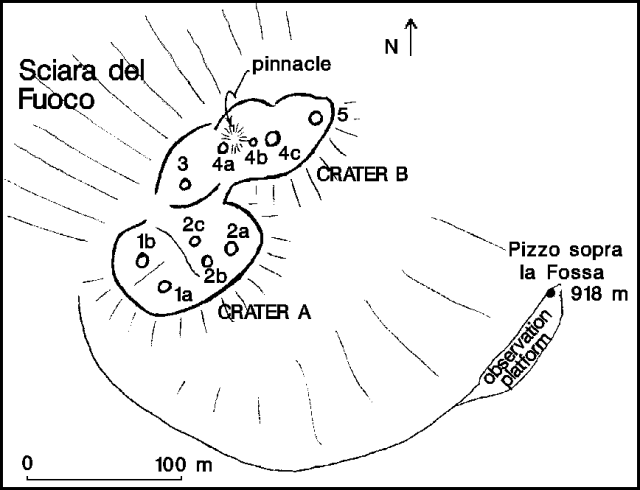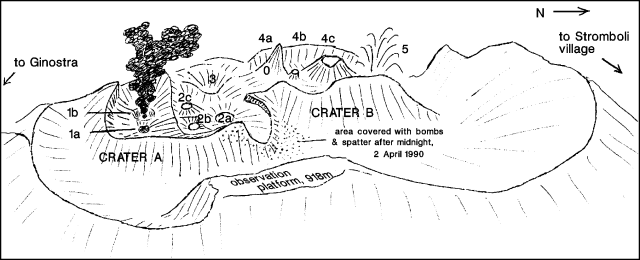Report on Stromboli (Italy) — April 1990
Bulletin of the Global Volcanism Network, vol. 15, no. 4 (April 1990)
Managing Editor: Lindsay McClelland.
Stromboli (Italy) Lava fountaining and ash emission from several vents
Please cite this report as:
Global Volcanism Program, 1990. Report on Stromboli (Italy) (McClelland, L., ed.). Bulletin of the Global Volcanism Network, 15:4. Smithsonian Institution. https://doi.org/10.5479/si.GVP.BGVN199004-211040
Stromboli
Italy
38.789°N, 15.213°E; summit elev. 924 m
All times are local (unless otherwise noted)
Stromboli was visited on 29 March and 1-2 April. Poor weather on the 29th obscured the active summit vents until late afternoon, when six eruptive episodes were observed between 1745 and 1830. Five were accompanied by emission of dark gray to black ash plumes that rose 150-200 m above the two active vents. The activity produced lava fountains ~100 m high, often falling onto the Sciara del Fuoco. On one occasion, a large glowing block rolled down the NNW side of the Sciara to ~100 m below the vents.
Observations from the summit between 1730 on 1 April and 0200 the next morning revealed morphologic changes that had occurred in the vent area since September 1989 (14:09). Crater A [termed Crater 1 in previous reports; compare figure 2 and figure 3 below] included at least five vents, four of which were active. The vent that had been most active in September had collapsed, but a new deep vent that had formed 10-20 m to the NW produced an average of 2-3 eruptions/hour before midnight. Glowing spatter from the eruptions rarely escaped the vent, but black ash plumes rose ~100 m above the rim. Eruptions became more frequent and intense after midnight, with lava fountains rising to ~100 m above the rim, larger ash plumes, and heavy falls of bombs and spatter onto Crater A's NE rim (figure 4). Each of the eruptions was accompanied by a few seconds of deep but not very loud rumbling. In the NE part of Crater A, a cluster of open vents (several very small and three larger) contained active magma and glowed intensely at night. They emitted burning gases but no spatter.
 |
Figure 3. Sketch map of the summit area of Stromboli showing vent configurations observed 1-2 April 1990. Courtesy of B. Behncke. |
 |
Figure 4. Oblique sketch of the summit area of Stromboli, looking roughly W. Courtesy of B. Behncke. |
Crater B [coalesced from craters formerly termed 2, 3, and 4; compare figures 2 and 3 below] included at least 4 vents, and others were probably hidden from view by intense gas emission and topographic obstacles. In its center was a symmetrical spatter cone 10-15 m high with a glowing summit vent and a small steaming hornito near its SW base. The cone was covered with yellowish green sublimates and was not ejecting tephra. Vent 5, frequently active in September, erupted only once every 1-2 hours. Its eruptions lasted up to 30 seconds, sometimes consisting of several pulses of lava fountains that reached 100 m above the rim, accompanied by loud rumbling. Vigorous emission of gas (smelling strongly of H2S and [SO2]) from the E wall of Crater B obscured vent 5 from direct observation. Vent 4a, at most 2 m in diameter, was near the base of a steep pinnacle, possibly a hornito, ~10 m high. The vent produced very loud high-pressure gas emissions, sometimes lasting 20 seconds, every 20-30 minutes, feeding a very faint bluish gas column ~20-30 m high. A few were accompanied by ejection of several glowing blocks, probably from the conduit walls. A slight continuous tremor was felt from ~50 m away during one of the gas emission episodes. Vent 3, between craters A and B, remained inactive during the observation period.
During the afternoon of 3 April, ash emission reportedly became stronger and could be seen from villages on the SE and E sides of the island.
Geological Summary. Spectacular incandescent nighttime explosions at Stromboli have long attracted visitors to the "Lighthouse of the Mediterranean" in the NE Aeolian Islands. This volcano has lent its name to the frequent mild explosive activity that has characterized its eruptions throughout much of historical time. The small island is the emergent summit of a volcano that grew in two main eruptive cycles, the last of which formed the western portion of the island. The Neostromboli eruptive period took place between about 13,000 and 5,000 years ago. The active summit vents are located at the head of the Sciara del Fuoco, a prominent scarp that formed about 5,000 years ago due to a series of slope failures which extends to below sea level. The modern volcano has been constructed within this scarp, which funnels pyroclastic ejecta and lava flows to the NW. Essentially continuous mild Strombolian explosions, sometimes accompanied by lava flows, have been recorded for more than a millennium.
Information Contacts: B. Behncke, Ruhr Univ, Germany.

